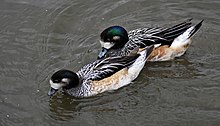Chiloé wigeon
| Chiloé wigeon | |
|---|---|
 |
|
| Male (rear) and female (front) | |
| Scientific classification | |
| Kingdom: | Animalia |
| Phylum: | Chordata |
| Class: | Aves |
| Order: | Anseriformes |
| Family: | Anatidae |
| Subfamily: | Anatinae |
| Genus: | Anas |
| Subgenus: | Mareca |
| Species: | A. sibilatrix |
| Binomial name | |
|
Anas sibilatrix Poeppig, 1829 |
|
The Chiloé wigeon (Anas sibilatrix), also known as the southern wigeon, is one of three extant species of wigeon in the genus Anas of the dabbling duck subfamily. This bird is indigenous to the southern part of South America, including the Chiloé Archipelago. In its native range, it is called the pato ("piebald duck") or pato real ("royal duck"), although the latter name also refers to the Muscovy in the wild. Its specific epithet, , means 'whistler', referring to the bird's call.
The Chiloé wigeon has a body length of 46 to 56 cm (18 to 22 in) and a wingspan of 75 to 86 cm (30 to 34 in). The wing length is about 25 cm (9.8 in) and the weight is approximately 800 g (28 oz).
This bird has an iridescent green-blue cap on its head, and a bluish gray bill with a black tip. The cheeks and forehead are white, the eyes are dark brown, and there is a white auricular patch. The neck and occipital part of the head are black. The breast is barred black and white and the plumage of the wings is gray and white. The flanks of males are rust colored, and light brown on females. The legs and feet are gray.
Sexual dimorphism is relatively subtle in this species of wigeon. Males are usually somewhat larger and heavier, and with somewhat brighter plumage and more strongly pronounced iridescence of the cap. Apart from these features, it can be difficult to distinguish the two sexes. Juveniles resemble adult birds, but the rust coloring on the flanks is diminished or absent.
This duck is indigenous to the southern part of South America, where it is found on freshwater lakes, marshes, shallow lagoons and slow flowing rivers. Vagrants have been observed in South Georgia, South Orkney and the South Shetland Islands.
...
Wikipedia

